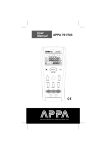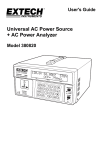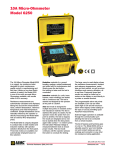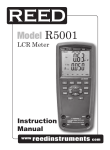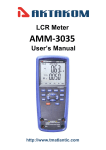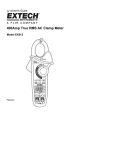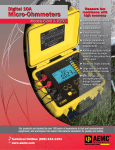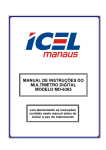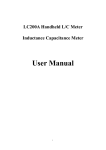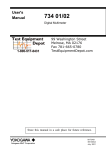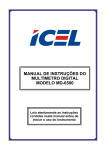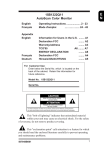Download manual
Transcript
Hand-held LCR Meter LCR-914/915/916 Series USER MANUAL GW INSTEK PART NO. 82CR-91600MA1 ISO-9001 CERTIFIED MANUFACTURER This manual contains proprietary information, which is protected by copyright. All rights are reserved. No part of this manual may be photocopied, reproduced or translated to another language without prior written consent of Good Will company. The information in this manual was correct at the time of printing. However, Good Will continues to improve products and reserves the right to change specification, equipment, and maintenance procedures at any time without notice. Good Will Instrument Co., Ltd. No. 7-1, Jhongsing Rd., Tucheng Dist., New Taipei City 236, Taiwan. LCR-914/915/916 User Manual Warning Safety sheet .......... .......... .......... ........ ......... .......... .......... ........ ......... Read First Safety Information Understand and follow the operating instructions carefully. Use the meter only as specified in this manual; otherwise, the protection provided by the meter may be impaired. WARNING Identifies hazardous conditions and actions that could cause BODILY HARM or DEATH. CAUTION Identifies conditions and actions that could DAMAGE the meter or equipment under test. WARNING ˙ When using test leads or probes, keep your fingers behind the finger guards. ˙ Remove test leads from the Meter before opening the battery door or the Meter case. ˙ Use the Meter only as specified in this manual or the protection by the Meter might be impaired. ˙ Always use the correct terminals, switch positions, and ranges for measurements. ˙ Do not apply more than the rated voltage, as marked on Meter, between terminals or between any terminal and earth ground. ˙ Use caution with voltages above 30 Vac rms, 42 Vac peak, or 60 Vdc. These voltages pose a shock hazard. ˙ To avoid false readings that can lead to electric shock and injury, replace the battery when the low battery indicator appears. ˙ Discharge all high-voltage capacitors before testing. ˙ Do not use the Meter around explosive gas or vapor. ˙ To reduce the risk of fire or electric shock do not expose this product to rain or moisture. 1 LCR-914/915/916 User Manual CAUTION ˙ Never connect a source of voltage that could result in damage to the meter and the equipment under test. ˙ Do not expose the Meter to extremes in temperature or high humidity. Symbols as Marked on the Meter and the Instruction Manual Risk of electric shock See instruction manual DC measurement Battery Fuse Earth AC measurement Conforms to EU directives Do not discard this product or throw away. Maintenance Do not attempt to repair this Meter. It contains no user serviceable parts. Repair or servicing should only be performed by qualified personnel. Cleaning Periodically wipe the case with a dry cloth and detergent. Do not use abrasives or solvents. 2 LCR-914/915/916 User Manual Meter Description Front Panel Illustration 1. LCD display: 20000/2000 counts. 2. Function buttons. 3. 5-Wire input terminal for SMD test probe or DIP part. 4. 2-Wire input terminal for Alligator Clips. 3 LCR-914/915/916 User Manual Package Contents 1. 5V AC Adapter (only LCR-916). 2. USB Cable (only LCR-916). 3. Shorting Cube. 4. SMD Test Probe (only LCR-916). 5. Alligator Clip Set. 6. Hanging Kit (only LCR-915/916). 4 LCR-914/915/916 User Manual Measuring Principles E R j(X L X C ) X XC R 2 (X L X C ) tan 1 L R X L 2fL L Z XC 1 1 2fC C XL XC R tan 1 Q 1 tan D Series Measurement Z RS jX S Parallel Measurement Y 1 1 RP jXP 5 LCR-914/915/916 User Manual Phase Drawing 6 LCR-914/915/916 User Manual Making 5-Wire Measurements with the SMD Test Probe 7 LCR-914/915/916 User Manual Making 4-Wire Measurements with the 5-Wire Terminal Making 2-Wire Measurements with the Alligator Clip Set 8 LCR-914/915/916 User Manual Measuring L/C/R/DCR • Press the L/C/R/DCR button to select the measurement function. • Press the L/C/R/DCR button for 2 seconds to enter the Auto L/C/R function. 9 LCR-914/915/916 User Manual Measuring D/Q/ESR/θ • Press the D/Q/ESR/θbutton to select the measurement function. 10 LCR-914/915/916 User Manual Selecting the Test Frequency • Press the FREQ button to select the test frequency. • The selectable frequency range depends on the model: LCR-914: 100Hz, 120Hz, 1kHz. LCR-915: 100Hz, 120Hz, 1kHz, 10kHz. LCR-916: 100Hz, 120Hz, 1kHz, 10kHz, 100kHz. 11 LCR-914/915/916 User Manual Selecting the Series / Parallel Measurement Function • At the L/C/R measuring function, it defaults to Auto Series / Parallel measuring function. • Press the SER/PAL button to select the measuring function. 12 LCR-914/915/916 User Manual Selecting the Display Count • Press the 2000 /20000 button to select the display count. Zero The Zero mode records the current input value as a reference and displays the reference on the sub display. Any inputs after this will be subtracted from the reference value and displayed on the main display. To use the Zero mode, follow the steps below. 1. Press the Zero button to enter Zero mode. The “Δ” symbol appears on the display. 2. Press the Zero button again to record a new input value as a reference. 3. Hold the Zero button for 2 seconds to exit this mode. 13 LCR-914/915/916 User Manual Display Hold • Press the HOLD button to hold the reading on the meter, press the button again to return. Display MAX/MIN The MAX/MIN mode records the maximum and the minimum input values. When the inputs go below the recorded minimum value or above the recorded maximum value, the meter beeps and records the new value. To use the MAX/MIN mode, follow the steps below: 1. Press the MAX/MIN button to enter the MAX/MIN mode. The “MAX” icon appears on the display. The maximum value is shown on the main display and the current value is shown on the sub display. 2. Press the MAX/MIN button to select the MAX or MIN mode. 3. Press the MAX/MIN button for 2 seconds to exit this mode. Note: This function is only for LCR-916. 14 LCR-914/915/916 User Manual Calibratation In order to achieve the best measurement results, calibration is essential. To calibrate the meter, press the CAL button. 15 LCR-914/915/916 User Manual When “OPEn” appears on the sub display, make the terminal or the SMD test probe open, and press the CAL button to start the open calibration. About 30 seconds later, the result of the open calibration appears on the main display. If the result is “pass”, press the CAL button to proceed to the next step. If the result is “fail”, press the CAL button to exit the function. 16 LCR-914/915/916 User Manual When “Srt” appears on the sub display, short the terminals or the SMD test probe, and then press the CAL button to start the short calibration. About 30 seconds later, the result of the short calibration appears on the main display. If the result is “pass”, press the CAL button to complete the calibration. If the result is “fail”, press the CAL button to exit the function. 17 LCR-914/915/916 User Manual Sorting To check the accuracy of a part, press the SORTING button to enter the sorting mode. The sorting result appears on the main display, and the current value appears on the sub display. 18 LCR-914/915/916 User Manual The default sorting standard value is the current value, and the default tolerance is ±1.0%. Setup Sorting Standard To setup the sorting standard value, follow the steps below: 1. Press the SETUP button to enter the setup mode. 2. Press and button to setup the range of the standard value. Then press the ENTER button to save the setup value and enter the next step. 3. Press , , and button to setup the standard value. Then press the ENTER button to save the setup value and enter the next step. 4. Press and button to setup the tolerance value. Then press the ENTER button to save the setup value and exit this mode. 19 LCR-914/915/916 User Manual Battery Replacement Refer to the following figure to replace the batteries : Caution ˙ Replace the batteries as soon as the low battery indicator appears, to avoid false reading. ˙ 1.5V x 4 alkaline batteries. External Power Source Save battery power by using the external power source. ˙1.5V x 4 alkaline batteries. Caution ˙Use the 5V AC adapter only as specified in this manual. ˙Do not use other power sources with the meter. 20 LCR-914/915/916 User Manual Specifications General Specifications Maximum voltage applied to any terminal: 30VDC or 30VAC rms Display: 2000/20000 counts Overrange Indication: OL Battery Life: 80 hours Low Battery Indicator: " " is displayed when the battery voltage drops below the operating voltage. Low battery voltage: Approx. 4.5V Auto Power Off: 10 minutes. Operating Temperature: No-condensation ≦10°C, 11°C ~ 30°C (≦80% RH), 30°C ~ 40°C (≦75% RH), 40°C ~ 50°C (≦45%RH) Storage Temperature: -20°C to 60°C, 0 to 80% R.H. (batteries not fitted) Temperature Coefficient: 0.15 x (Spec.Accy) / °C, < 18°C or > 28°C. Measurement: Samples 1.25 times per second normal. Altitude: 6561.7 ft (2000m). Weight: (630g) including battery. Dimensions (W x H x D): 95mm x 207mm x 52mm with holster. Accessories: Accessory LCR-916 LCR-915 LCR-914 1. Shorting Cube Standard Standard Standard 2. 2Wire Alligator Standard Standard Standard Clip Set 3. Magnetic Hang Standard Standard Optional Kit 4. Battery Standard Standard Standard 5. User Manual Standard Standard Standard 6. SMD Test Probe Standard Optional Optional 7. AC Adapter Standard Optional 8. USB Cable Standard Optional Optional Optional 9. PC Software CD Standard Optional N/A 10. 4Wire DIP Clip Optional Optional Optional Set Power Requirements: 1.5V x 4 IEC LR6 or AA size. External Power Requirements: DC 5V (USB cable or AC adapter) Pollution Degree: 2 Safety: Complies with EN 61010-1, IEC 61010-1 EMC: EN 61326-1 21 LCR-914/915/916 User Manual Shock Vibration: Sinusoidal vibration per MIL-T- 28800E (5 ~ 55 Hz, 3g maximum). Drop Protection: 4 feet drop to hardwood on concrete floor. Indoor Use. Electrical Specifications (1) Test Frequency Range Resolution Accuracy 100.00 Hz 0.01 Hz ± 0.01% 120.00 Hz 0.01 Hz ± 0.01% 1.0000 kHz 0.1 Hz ± 0.01% [1] 10.000 kHz 1 Hz ± 0.01% [2] 100.00 kHz 10 Hz ± 0.01% [1] The 10kHz test frequency is only for the LCR-915/916. [2] The 100kHz test frequency is only for the LCR-916. (2) Test Signal AC Signal Level: 600mVrms AC Signal Accuracy: ±10% DC Bias Level: 1V DC Bias Accuracy: ±10% (3) Test Cable Model SMD Test Probe 4-Wire Test Probe Alligator Clip Set Length 60cm 60cm 15cm Bandwidth 1MHz 1MHz 1kHz Type 5-Wire 5-Wire 2-Wire Accuracy: ±(A x B)(% of reading) A: Basic Accuracy as specified by B: Test Cable Accuracy B(%) = 1 + (L x F x T) L(m): Cable length F(MHz): Test frequency T: Cable type. If the cable is 5-wire type, then “T” is 40, else “T” is 4,000. When measuring by basic accuracy, the following conditions must be met: 1. Ambient temperature: 23˚C ± 5˚C < 80% RH. 2. Test cable length: 0m 3. Open and short calibration has been performed 4. D ≤ 0.1 for C, L measurements; Q ≤ 0.1 for R measurements. See the operation manual for additional details. 22 LCR-914/915/916 User Manual (4) Inductance Frequency Range Accuracy [2] 20.000mH ± (0.5% + 5d) 200.00mH 2000.0mH ± (0.2% + 2d) 100Hz 20.000H 120Hz 200.00H 2000.0H ± (0.5% + 2d) [2] 20.000kH ± (1.0% + 2d) [2] 2000.0uH ± (0.5% + 5d) 20.000mH 200.00mH ± (0.2% + 2d) 1kHz 2000.0mH 20.000H 200.00H ± (0.5% + 2d) [2] 2000.0H ± (1.0% + 2d) [2] 200.00uH ± (0.5% + 5d) 2000.0uH 20.000mH ± (0.2% + 2d) [1] 10kHz 200.00mH 2000.0mH ± (2.0% + 2d) 20.000H ± (5.0% + 2d) [2] 20.000uH ± (0.5% + 5d) 200.00uH ± (0.2% + 2d) [3] 100kHz 2000.0uH 20.000mH ± (2.0% + 2d) 200.00mH ± (5.0% + 2d) [1] The 10kHz test frequency is only for the LCR-915/916. [2] The measuring time is 2 seconds. [3] The 100kHz test frequency is only for the LCR-916. Input Protection: 30VDC or 30VAC rms Minimum Resolution: 0.001uH in the 20.000uH range. Measuring Time: 800ms Note: If D > 0.1, the accuracy should be multiplied by 23 1 D2 LCR-914/915/916 User Manual (5) Capacitance Frequency Range Accuracy [2] 2000.0pF ± (0.5% + 5d) 20.000nF 200.00nF ± (0.2% + 2d) 2000.0nF 100Hz 120Hz 20.000uF 200.00uF ± (0.5% + 2d) 2000.0uF ± (1.0% + 2d) [2] 20.000mF ± (2.0% + 2d) [2] 2000.0pF ± (0.5% + 5d) 20.000nF 200.00nF ± (0.2% + 2d) 1kHz 2000.0nF 20.000uF ± (0.5% + 2d) 200.00uF ± (1.0% + 2d) [2] 2000.0uF ± (2.0% + 2d) [2] 200.00pF ± (0.5% + 5d) 2000.0pF 20.000nF ± (0.2% + 2d) [1] 10kHz 200.00nF 2000.0nF 20.000uF ± (2.0% + 2d) [2] 200.00uF ± (5.0% + 2d) [2] 20.000pF ± (0.5% + 20d) 200.00pF 2000.0pF ± (0.2% + 2d) [3] 100kHz 20.000nF 200.00nF 2000.0nF ± (2.0% + 2d) [2] 20.000uF ± (5.0% + 2d) [1] The 10kHz test frequency is only for the LCR-915/916. [2] The measuring time is 2 seconds. [3] The 100kHz test frequency is only for the LCR-916. Input Protection: 30VDC or 30VAC rms Minimum Resolution: 0.001pF in the 20.000pF range. Measuring Time: 800ms Note: If D > 0.1, the accuracy should be multiplied by 24 1 D2 LCR-914/915/916 User Manual (6) Resistance Frequency Range Accuracy 200.00Ω ± (0.2% + 5d) 2.0000kΩ 20.000kΩ ± (0.2% + 2d) 100Hz 200.00kΩ 120Hz 2.0000MΩ 20.000MΩ ± (0.5% + 2d) [2] 200.00MΩ ± (1.0% + 2d) [2] 20.000Ω ± (0.5% + 5d) 200.00Ω 2.0000kΩ 20.000kΩ ± (0.2% + 2d) 1kHz 200.00kΩ 2.0000MΩ 20.000MΩ ± (2.0% + 2d) [2] 200.00MΩ ± (5.0% + 2d) [2] 20.000Ω ± (0.5% + 5d) 200.00Ω 2.0000kΩ ± (0.2% + 2d) [1] 10kHz 20.000kΩ 200.00kΩ 2.0000MΩ ± (2.0% + 2d) 20.000MΩ ± (5.0% + 2d) [2] 20.000Ω ± (0.5% + 5d) 200.00Ω 2.0000kΩ ± (0.2% + 2d) [3] 100kHz 20.000kΩ 200.00kΩ ± (2.0% + 2d) 2.0000MΩ ± (5.0% + 2d) [1] The 10kHz test frequency is only for the LCR-915/916. [2] The measuring time is 2 seconds. [3] The 100kHz test frequency is only for the LCR-916. Input Protection: 30VDC or 30VAC rms Minimum Resolution: 0.001Ω in the 20.000Ω range. Measuring Time: 800ms Note: If Q > 0.1, the accuracy should be multiplied by 1 Q 2 25 LCR-914/915/916 User Manual (7) DCR Range 200.00Ω 2.0000kΩ 20.000kΩ 200.00kΩ 2.0000MΩ 20.000MΩ 200.00MΩ [1] < 50dgt rolling. Resolution 0.01Ω 0.0001kΩ 0.001kΩ 0.01kΩ 0.0001MΩ 0.001MΩ 0.01MΩ Accuracy ± (0.2% + 5d) ± (0.2% + 2d) ± (0.5% + 2d) [1] ± (1.0% + 2d) Input Protection: 30VDC or 30VAC rms Minimum Resolution: 0.01Ω in the 200.00Ω range. Measuring Time: 2 seconds (8) D & Q Definition Q=1/D Range: 2.000 ~ 2000 Minimum Resolution: 0.001 in the 2.000 range. Accuracy: Accuracy of Main Reading x (1+D) Input Protection: 30VDC or 30VAC rms (9) ESR The specification for ESR is the same as Resistance. (10) θ Range -90.0° ~ 90.0° Resolution 0.1° Input Protection: 30VDC or 30VAC rms 26 Accuracy ± (0.2% + 5d)





























